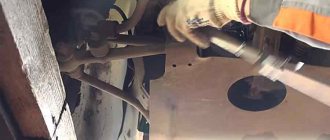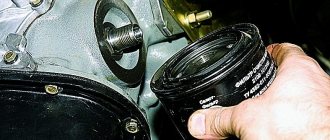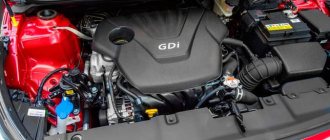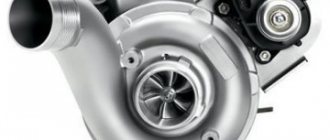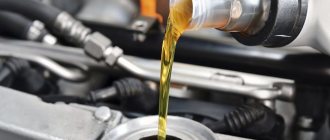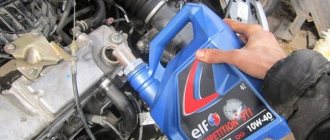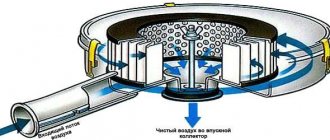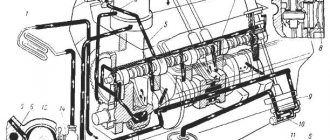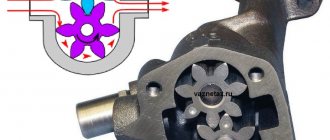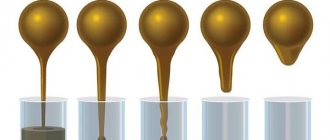The main reasons for this problem
For experienced motorists with extensive driving experience, a situation where oil has been squeezed out through the oil filter may be due to the following:
- serious malfunction of the valve itself;
- large discrepancy between the viscosity of the lubricant and the characteristics of the power unit;
- weak fixation of the filter itself on the surface of the fitting;
- severe contamination of the filter surface, which made it difficult for the lubricant to pass through the filter paper;
- use of low-quality polymer-type sealant.
List of main conditions causing oil filter leakage
- A very common reason is the squeezing out of the lubricant when starting the unit in winter. Under such conditions, the oil that has thickened in the cold is not capable of leaking through the membrane layers due to its structure. As a result, a jelly-like lubricant under strong pressure breaks through the layers of the membrane and flows out at the base through the thread channels.
- Incorrect operation of the oil pump, which at high speeds creates excess pressure, which can squeeze oil through all possible leaky areas. Very often the oil filter is the weakest point.
- In the case of using a brand of oils with increased oil viscosity in severe frost conditions. Such a mistake can occur either due to the inexperience of a novice motorist or as a result of purchasing a counterfeit product.
If oil has been squeezed out through the oil filter, the cause has already been determined, you need to immediately begin eliminating it.
How to eliminate lubricant leakage through the filter
If the oil has been squeezed out through the oil filter and the cause has already been found, then you need to start eliminating the leak. To carry out repair work, you need to prepare a set of keys and some rags.
The entire repair process consists of the following activities:
- using keys, remove the timing belt cover;
- the auto valve plug is unscrewed;
- the spring is carefully removed;
- the valve is removed and checked for scoring or other types of mechanical damage;
Briefly about the reasons
Let's start with a clogged oil deflector drain. Since it is clogged, the remaining engine lubricant simply cannot return back to the crankcase. Because of this, they begin to gradually exit through the air filter, taking crankcase gases with them.
The problem may also lie in a blockage in the hoses and corrugations, which are responsible for the removal of already exhaust crankcase gas. Either there is a malfunction in the pipe in the form of deformation or mechanical damage. That is, a certain obstacle appears to the removal of gas. Therefore, there will be a partial release of motor lubricant and gases directly through the engine air purification system. Read on to find out how you can solve this problem. Plus, always check your owner's manual.
A cause related to wear, damage, or even stuck piston rings cannot be ruled out. If this happens, the rings no longer perform the task of collecting excess lubricant, and they gradually end up in the crankcase.
Because of this, already dirty oil will be squeezed out, passing through the oil slinger and motor valves necessary to provide ventilation.
The next reason is a blockage in the air filter itself. It is with this that such malfunctions are most often associated.
Many drivers, which is quite objective and there is no point in hiding it, simply do not take care of their car. They forget to change consumables or simply ignore the need for such procedures. A clogged filter not only interferes with the efficiency of the internal combustion engine, but can also allow oil to penetrate into it. Since access to air is blocked, there is a deficiency of oxygen. This forces the engine to use air bleed. The crankcase becomes one of the sources of air.
If the car owner has not changed a consumable in the form of an air filter for a long time, the first step is to remove it and evaluate the current condition.
It often turns out that the reason is simply an old filter.
To check, you need to install a new consumable, drive 5-10 kilometers, remove it and examine it visually. If there are no oil stains, that was the reason.
But when spots appear immediately on a new filter, you will have to conduct a more detailed check and look for the source of the problem.
Do not forget that a clogged air purifier entering the engine can be one of the main reasons why the engine starts and immediately stalls.
How to choose a quality filter
Very often, oil leakage can occur due to the use of a low-quality filter.
In order not to buy a low-quality counterfeit, you must remember the following:
- When purchasing an oil filter, you should pay attention to the condition of the packaging. If there are signs of deformation and there are large holes in the case, then this is a sure sign of counterfeit.
- It is necessary to study the technical condition of the polymer sealing ring and the filter membrane. The height of the sealing ring should not be more than 0.8 mm. above the surface of the lid. A high-quality membrane should be free of irregularities and of the same color.
- You need to buy a filter only in certified auto stores that have official registration and a long period of operation.
- You should not chase cheap filters, since very often low-quality material is used for their manufacture, and they have a limited service life. By applying the above recommendations in practice, you can minimize the likelihood of purchasing a filter with low technical characteristics.
Why oil squeezes out from under the filter: reasons, photo and video review
The main reason why oil is squeezed out from under the filter, as a rule, is starting a cold engine. At this moment, the consistency of the lubricant is so thick that it simply does not have time to pass through the oil filter.
Oil leak
This usually occurs on older vehicles that have an oil pump that does not have a bypass valve. This certainly cannot happen with new cars, except perhaps if it is not tightened well enough, and then it presses oil from under the filter.
Main causes and ways to eliminate them
There can be many reasons that cause oil leakage, there can be several main ones, let’s look at them:
If everything is in order with the lubricant and filter, but oil is squeezed out through the oil filter again, then perhaps the pump itself is faulty, namely the pressure reducing valve.
Extruded lubricant mixture
Fixing the problem
The valve can be removed without removing the pump itself.
What will you need?
Stages
- Remove the timing belt cover.
- Unscrew the auto valve plug.
- We remove the spring.
- We take out the valve and check it for scratches and mechanical damage.
- Check the condition of the spring itself.
There should be no kinks on it, and the height should be 44.72 millimeters, otherwise replace it.
We have listed almost all the possible reasons why lubricant is leaking; if even after this the problem is not resolved, then you should seek help from professionals at a service station.
It is possible that they will be able to find something else and fix the leak.
Video “Grease leaked”
This video shows why a lubricant leak occurred and what can be done to fix it. In this case, the rubber band was distorted due to careless actions of the mechanic at the service station.
- Review of the Geely MK oil filter
- Tips for selecting an oil filter
- Engine oil: how much to pour and what does it depend on?
and reviews
And if you put a closed electric hotplate on to heat the engine, then it may be that the oil overheated and something got under the valve and it jammed, and squeezed the oil out from under the filter.
Ivan Ivanovich Baranov
Experience working at a service station:
View all answers
Avtozam.com is your assistant in car repair and maintenance
Your use of this website constitutes your agreement that your use is at your own risk.
While operating a car, car owners often encounter trouble in the form of a leak from the oil filter.
A puddle that forms under a car is an unpleasant situation and exciting for the driver. An oil leak in the filter area does not bode well, as it hides a number of unfavorable factors.
This problem can occur both in a used car and in almost new internal combustion engines.
We recommend: Mobil 1 oil
Some experienced drivers solve this issue by tightening the filter housing, as they believe that a similar problem arises as a result of:
- valve malfunction;
- inconsistencies in the viscosity of the lubricating fluid;
- low-quality polymer seal.
The reason may also be poor fixation of the filtrate on the fitting or its contamination.
The main mistake made by drivers, which results in oil being squeezed out through the oil filter, is considered to be a cold start of the engine at high speeds. This is especially common in used cars. This is absolutely not necessary, since oil compositions, especially those of mineral origin, thicken in the cold and become like jelly.
The pump produces high pressure at higher speeds and can force lubricant through any leaky areas. In addition, in this mode, damage to the seals on the crankshaft is possible, and this is fraught with repairs and unplanned expenses.
Renumax is a revolutionary scratch remover! Don't waste money on repainting! Now you can remove any scratch from the body of your car in just 5 seconds.
Innaqua system – protect your car for 12 months with the Innaqua system nano-product!
If you often have to deal with frost, it is recommended to change the previous composition to oil with a viscosity of 0w20 and a filter with a spring mechanism.
Another well-known mistake that causes oil to be squeezed out from under the oil filter is the use of fast-acting substances that can quickly restore contact between rubbing parts. It is worth considering that the use of components is considered by the system as garbage and it will settle on the filtrate, interfering with the movement of the oil flow and, as a result, the lubricant is squeezed out through the seals.
There are several other important situations when a squeezing effect through the oil filtrate may occur:
- When changing the oil, it is not recommended to skimp on flushing materials and use “old-fashioned” methods of flushing the lubrication system, namely mixing unsafe compounds in the form of kerosene with acetone or benzene. Such connections, or rather part of them, will remain in the system forever, and this causes deformation of the seals.
- The usual addition of lubricating fluid to the previous composition. This habit is detrimental for some drivers who drive on the same oil for a long time. As a result of this action, a huge amount of undesirable impurities accumulates in the lubricant mixture
- Poor quality consumables. Using surrogates instead of regular oil with low-quality characteristics.
The fuel and lubricants market is already overcrowded with low-quality products. Therefore, it’s easy to fall for the bait of unscrupulous sellers. There are several distinctive signs by which you can determine whether the material is fake or not.
The first parameter of a low-quality oil filter is the packaging geometry. If the case is deformed, then this is one of the signs of counterfeit. You can check the quality properties of the filtrate in another simple way, namely by blowing into the inlet holes. If the product is of high quality, then the petal should not open, but in a fake it’s the opposite.
It is worth paying attention to the polymer sealing ring and monitoring the condition of the filter paper. If a paper accordion has unevenness or different colors, then it is a fake. As for the polymer ring, its height should not exceed 0.8 mm above the level of the lid.
Why did the oil filter rupture?
On modern car enthusiast forums, there is often a discussion of the problem, why does the oil filter break? How to prevent this situation, which can lead to a lot of unpleasant and even dangerous consequences?
Nowadays, cars are used for longer periods of time and, as a rule, have more than one owner - many people no longer buy new cars. Therefore, the issue of maintaining the engine in a clean condition for trouble-free and safe operation of the machine is one of the most important. An integral part of the proper operation of a car is the regular replacement of its oil filter.
An oil filter is a special device designed specifically to prevent the passage of engine pollutants contained in motor, lubricating and transmission fluids.
The first automobile oil filter was a partial-flow filter—only a small portion of the oil passed through the filter before entering the engine. The rest of it went directly into the motor.
The first full-flow automobile appeared in the middle of the last century. Its design provided that all oil passed through a filtration system before entering the engine. But for the filter to work effectively, it is necessary that the volume of oil in it and the oil pressure do not exceed a certain value. Today, some automotive systems use both types of filters.
The oil pump is connected directly to the engine. Oil pressure is a value that directly depends on the engine speed. To limit the maximum oil pressure, a safety valve is provided, which is an integral part of the oil pump.
Summary
Diagnostics and recommendations on what exactly to do will help you find out why oil is leaking from under a newly installed oil filter:
- Does the lubricant level in the engine crankcase exceed the MAX mark on the dipstick? If yes, remove some of the liquid.
- Is the wiper housing tightly pulled to the cylinder block? No - tighten it 1/2-3/4 turn.
- Is the thread broken? Yes - the steps depend on the specific car: install a longer stud, install a new tip, cut a new one...
- Is the correct oil filled? No - replace the emulsion.
- Is the filter part too tight? If yes, it will not twist when significant force is applied. Unscrew the filter element and look at the seal - deformation and cracks are not allowed, otherwise only replacement.
- Is the component original and of high quality? No - replace.
If there is pressure on the lubricant and the oil pressure lamp is on, the filter is dirty and the bypass valve is clogged. On cars with an impressive mileage, the cause of the leak may be a faulty pressure relief valve. Both problems often manifest themselves during the interregulatory period.
Why did the oil filter burst?
As a rule, the safety valve sets a pressure limit in the oil system from 3 to 5 kg/sq.cm.
If the oil pressure exceeds the specified limits, there is a risk that the centering washer and gaskets may be damaged or squeezed out of their seats. When the oil pressure is very high and the relief valve does not open, the following may occur:
- the gaskets are squeezed out of their seats, and oil begins to be knocked out of the filter;
- the oil filter swells (this is what causes the oil filter to rupture).
In such cases, often unfairly, the oil filter is blamed, although in fact it is usually the pump safety valve that is at fault. After the engine and oil pump have cooled (restored), the safety valve itself begins to operate smoothly again, so the reason why the oil filter ruptured is difficult to detect.
To prevent too large pressure drops between the clean and dirty sides of the filter element, a bypass valve is installed in the filter design (it opens at a pressure drop of 1-2 kg/sq. cm). This creates conditions so that even unrefined oil (with increasing pressure) can lubricate the rubbing parts of the engine, even if the filter element is completely clogged with dirt.
The filter design also includes an anti-drainage valve that prevents oil from draining from the filter back into the crankcase when the engine is turned off. Some filters are equipped with an anti-siphon pipe, which also prevents oil from draining after the engine is turned off.
Important! Pressure drops in the filter, such as its resource, such as dirt holding capacity, must meet the requirements of OEM - automobile manufacturing plants. Therefore, if the oil filter bursts, to replace it you need to select this car part, carefully taking into account many specific parameters, and not just the overall and connecting dimensions.
For example, if a VAZ oil filter ruptures, it is recommended to replace it with a new original or certified high-quality analogue. Often, outwardly similar, but cheaper filters differ greatly from high-quality ones, correctly designed for a particular car, in terms of filtration parameters.
Source
How to fix a leak from the oil filter
So, in most cases, it is enough to fill in high-quality oil, taking into account the manufacturer’s recommendations and seasonality, change or install the oil filter correctly.
If you have basic skills, you can easily cope with cleaning the crankcase ventilation system. This means that in most cases, almost every driver in a garage can fix an oil leak with his own hands.
As for more complex faults, these include a failed pressure relief valve and a damaged thread on the fitting for securing the oil filter. In practice, a problem with the valve is more common, so let's specifically focus on checking it.
The main task is to check the valve spring, which is located under the plug. It is she who is responsible for the operation of the device; the overall performance will depend on the state of the spring. The specified spring must be removed from its socket for inspection. The presence of burrs, creases, bends and other defects is not allowed. Also, the spring should be tight, not loose.
If the spring can be easily stretched by hand, this indicates a weakening of this element. Also, the overall length of the spring should not be increased, which would indicate stretching. A decrease in length is an indication that part of the spring has broken off. In such a situation, debris must also be removed from the valve seat. Detection of any defects in the spring is a reason to replace it.
